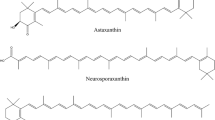Abstract
The carotenoid, neurosporene, is of commercial importance due to its use as an antioxidant and UV-B radiation protector. It is usually obtained from fruits and vegetables. Although some bacterial mutants can accumulate neurosporene, these are unstable. A recently-isolated, natural and stable neurosporene accumulating, phototrophic purple non-sulfur bacterium Rhodobacter viridis JA737 is described that accumulates neurosporene as the major (98 %) carotenoid up to ~7 mg g dry cell−1 and at 7.3 mg l−1.



Similar content being viewed by others
References
Harada J, Nagashima KVP, Takaichi S, Misawa N, Matsuura K, Shimada K (2001) Phytoene desaturase, CrtI, of the purple photosynthetic bacterium, Rubrivivax gelatinosus, produces both neurosporene and lycopene. Plant Cell Physiol 42:1112–1118
Khachik F (2006) Distribution and metabolism of dietary carotenoids in humans as a criterion for development of nutritional supplements. Pure Appl Chem 78:1551–1557
Khachik F, Carvalho L, Bernstein PS, Muir GJ, Zhao DY, Katz NB (2002) Chemistry, distribution, and metabolism of tomato carotenoids and their impact on human health. Exp Biol Med 227:845–851
Lakshmi KVNS, Sasikala Ch, Ashok Kumar GV, Chandrasekaran R, Ramana ChV (2011) Phaeovibrio sulfidiphilus gen. nov., sp. nov., phototrophic alphaproteobacteria isolated from brackish water. Int J Syst Evol Microbiol 61:828–832
Raj PS, Ramaprasad EVV, Vaseef S, Sasikala Ch, Ramana ChV (2012) Rhodobacter viridis sp. nov., a phototrophic bacterium isolated from Western Ghats of India. Int J Syst Evol Microbiol 63:181–186
Sandmann G, Kuhn S, Boger P (1998) Evaluation of structurally different carotenoids in Escherichia coli transformants as protectants against UV-B radiation. Appl Environ Microbiol 64:1972–1974
Scolnik PA, Walker MA, Marrs BL (1980) Biosynthesis of carotenoids derived from neurosporene in Rhodopseudomonas capsulata. J Biol Chem 255:2427–2432
Acknowledgments
EVVR acknowledge the Council of Scientific and Industrial Research (CSIR), New Delhi for the award of Senior Research fellowship.
Author information
Authors and Affiliations
Corresponding author
Rights and permissions
About this article
Cite this article
Ramaprasad, E.V.V., Sasikala, C. & Ramana, C.V. Neurosporene is the major carotenoid accumulated by Rhodobacter viridis JA737. Biotechnol Lett 35, 1093–1097 (2013). https://doi.org/10.1007/s10529-013-1181-y
Received:
Accepted:
Published:
Issue Date:
DOI: https://doi.org/10.1007/s10529-013-1181-y




